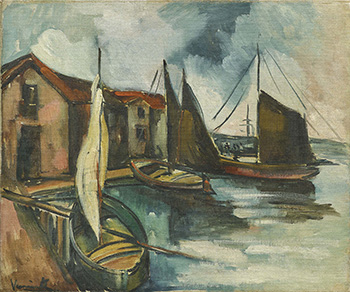PROVENANCE:
Dimensions Art Center, Taipei
Acquired from the above by the present owner
ILLUSTRATED:
Vlaminck , Dimensions Art Center, Taipei, 1992, color illustrated, p. 10 & p. 61
This work will be included in the forthcoming catalogue Critique de l'oeuvre de Maurice de Vlaminck , currently under preparation by Maïthé Vallès-Bled and Godeliève de Vlaminck under the sponsorship of the Wildenstein Institute.
This painting is to be sold with a certificate of authenticity issued by Wildenstein Institute, Paris.
Catalogue Note:
SOUTHAMPTON
MAURICE DE VLAMINCK
Maurice de Vlaminck was an important figure of the Fauves movement, Vlaminck was fond of seeking organic things as his main topics, such as French countryside, simple flower bouquet, or vast seascape, forests and farm scenes. It is through the use of strong contrasted colors and wild beast-like exaggerated brush works, that Vlaminck was able to transform the ordinary landscape into another world made of strong colors. From 1904 to 1907, Vlaminck’s beast-like painting style was known to many. In the year of 1905, Vlaminck was showing his works along with other Fauve artists at the Salon of Independents, and Autumn Salon, where they were showing unprecedented techniques, as were their uninhabited use of colors that ultimately ignited their fame.
Since 1908 onwards, there was a clear evidence of the influence of Cézanne over works of Vlaminck. Vlaminck darkened his palette and turned monochromatic, Vlaminck merged the style of Fauvism and Cezanne, and developed into his own while fading out from the Fauves. For the Fauvist artists, the key is not to paint in accordance to the colors of the reality, but from the heart. A fauvist painter must be true to his heart and deliver the pure sensations of his observations of the outer world. Hence, even though the Fauve was parted, they kept their experimental spirit and attitudes open to form their own individualistic style.
Vlaminck was invited by Ambroise Vollard, a significant art dealer of the 20th century to visit England during 1911, where Vlaminck stayed for a little while and painted the suburbs of London. Meanwhile, Vlaminck was faced with the peak development of Cubism, and was under the influence of them to certain extent, it was during this time, and Vlaminck began to experiment some use of geometric shapes and play of volumes in his works. Such as the work seen in “Southampton”, there are some subtle influences.
The present lot “Southampton” is a depiction of a harbor city located in the southern part of England, overlooking his hometown, France is 200 kilometers away. Vlaminck moved from Le Seine to the Thames, when faced with different landscapes, Vlaminck was still painting at ease. The composition of the “Southampton” is rich, with three sail boats resting by the harbor, the unsettling float of lines on the sea surface are counterbalanced with the stagnant houses on land. Vlaminck layered dark blue and white strokes as seen in the sky and sea, despite the colors are not as wild as previous years, the rough brush works remained, evenly scattered in the shadows, clouds and the walls. This painting not only represented the mature periods of Vlaminck, it also captured the impressions of Vlaminck as he stood in front of the harbor.
